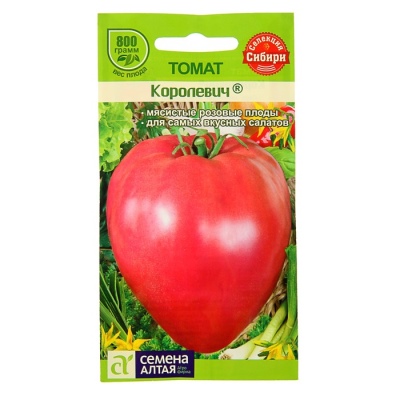
- Authors: Kudryavtseva G.A., Fotev Yu.V., Altunina L.P., Kotelnikova M.A., Kondakov S.N.
- Year of approval: 2008
- Category: grade
- Growth type: indeterminate
- Appointment: fresh consumption
- Ripening period: mid-season
- Growing conditions: for open ground
- Bush size: tall
- Leaves: medium, green
- Unripe fruit color: green
King's son - despite such a proud name, this plant is not too whimsical. However, it is not so easy to achieve a positive result when growing it. You will have to make serious efforts, and first, thoroughly study all the features of the culture.
Breeding history
Korolevich is a tomato developed by breeders in the 2000s. The official admission for its cultivation for consumer purposes was given in 2008. A whole group of specialists was working on the breeding project.
Description of the variety
Korolevich is one of the indeterminate tomatoes. It is recommended to grow it outdoors. The bushes of this tomato are tall. They develop medium-sized green foliage.
The main qualities of the fruit
Tomatoes initially born from the ovary will have a green color. When they are ripe, they will turn pink in color. The mass of a single large berry is on average 200 g. It will be similar in shape to a heart, the ribbing is not too pronounced. Tomatoes will be laid on simple inflorescences, and the articulation for the stalks is not very typical.
Taste characteristics
The fruits of this variety are optimal for fresh consumption. Attractive gastronomic properties are achieved even in the difficult Siberian climate. The characteristic gourmet taste is noted. It is sweet with a slight sour note. The pulp literally melts in your mouth.
Ripening and fruiting
The king's son ripens at the same time as most ordinary mid-ripening tomatoes. Harvesting usually begins in the second decade of August. Further, it covers the third decade and gradually fades away at the beginning of September.
Yield
The number of berries will be quite small. It will be approximately 2 kg per 1 sq. m. However, this result is achieved stably and confidently. You also need to take care of agricultural technology in order to get good results.
The timing of planting seedlings and planting in the ground
You need to sow seeds in planting containers in March. Usually, the readiness of seedlings for transshipment into open ground is achieved in 60-65 days after the emergence of seedlings. But an important role here is played by both the quality of the plants themselves, and the readiness of weather conditions, the heating of the site. The readiness of seedlings for planting is expressed in the presence of 6 or 7 leaves on each specimen. In the southern regions, open ground can be used, while in the north, the use of greenhouses is recommended.

Growing tomato seedlings is an extremely important process, because it largely depends on whether the gardener can harvest at all. All aspects must be taken into account, from seedbed preparation to planting in the ground.
Landing scheme
The distance between individual plants is normally 50 cm. Typical row spacings are 70 cm. If these parameters are observed, an optimal result can be guaranteed. But you need to understand that these are only the minimum recommended indicators.In case of urgent need, it is quite allowed to increase them.

Growing and caring
The Korolevich will not do without a garter and formation. If these necessary manipulations are abandoned, it is simply not necessary to count on the normal development of the landings. The plant is relatively resistant to most of the major pathologies typical of tomatoes. However, it would hardly be wise to ignore the need for processing. When the plantings of the King's son are watered, the root area is immediately loosened.
A mandatory measure of support will be weekly weeding of plantings. The formation of bushes occurs in 1 or 2 stems. It is these options that show the highest results. The developed shoots must be tied to strong supports so that they do not break under the arising load. Overdrying and excessive moistening of the earth are equally contraindicated for this variety. Organic dressings are applied once every 2 weeks, at your discretion, combining them with mineral compositions, or using it independently.




A plant needs different micronutrients at each stage of growth. All fertilizers can be divided into two groups: mineral and organic. Folk remedies are often used: iodine, yeast, bird droppings, eggshells.
It is important to observe the rate and period of feeding. This also applies to folk remedies and organic fertilizers.


Growing regions
There is nothing unusual in terms of permissible territories. Korolevich deserves planting in almost all of Russia, except for the regions of the Far North and those equated to them in terms of climatic indicators. This variety will delight residents:
Moscow region and Siberia;
The North Caucasus and the Far East;
Chernozem and Volga regions;
Urals and the north of the European part of the Russian Federation.
Review overview
The evaluations of the Korolevich tomato are certainly favorable. The fruits ripen early on it, which is very pleasing to consumers. The appearance of the crop is excellent and fully consistent with its inner virtues. Even when growing this variety for several years, no frustration arises. Those who tried it for the first year almost always strive to plant more bushes soon.

























































































